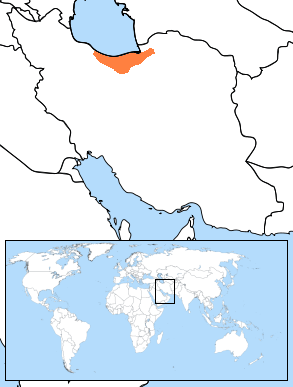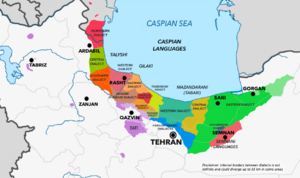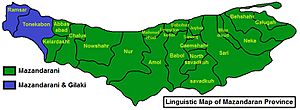Mazanderani language facts for kids
Quick facts for kids Mazandarani |
||||
|---|---|---|---|---|
| مازرونی (Mazoruni) طبری (Tabari) |
||||

Mazanderani (Mazoruni) written in Nastaliq script. (مازرونی)
|
||||
| Native to | Iran (Province of Mazandaran and parts of the provinces of Alborz, Tehran, Qazvin, Semnan and Golestan) | |||
| Region | South coast of the Caspian Sea | |||
| Ethnicity | Mazanderani people | |||
| Native speakers | 2 million (2019)e25 | |||
| Language family |
Indo-European
|
|||
| Dialects |
Gorgani-Mazandarani (East)
Katuli-Mazandarani (East)
Tabari-Mazandarani (Center)
Kojuri-Mazandarani (West)
Kelarestaqi-Mazandarani (West)
Gilaki-Mazandarani (West)
Galeshi-Mazandarani (South)
Taleqani-Mazandarani (South)
Shahmirzadi (South)
Ilikaei (South)
Qasrani (South)
|
|||
| Writing system | Persian alphabet | |||
| Official status | ||||
| Regulated by | None. But the Linguistic faculty of Mazandaran University officially gathers materials and resources about it. | |||

Areas where Mazandarani is spoken as the mother tongue
|
||||
|
||||
Mazandarani (مازندرانی), or Tabari (طبری), is an Iranian language of the Northwestern branch spoken by the Mazandarani people. As of 2019[update], there were 2 million native speakers. As a member of the Northwestern branch (the northern branch of Western Iranian), etymologically speaking, it is rather closely related to Gilaki and also related to Persian, which belongs to the Southwestern branch. Though the Persian language has influenced Mazandarani to a great extent, Mazandarani still survives as an independent language with a northwestern Iranian origin.
Mazandarani is closely related to Gilaki, and the two languages have similar vocabularies. The Gilaki and Mazandarani languages (but not other Iranian languages) share certain typological features with Caucasian languages (specifically the non-Indo-European South Caucasian languages), reflecting the history, ethnic identity, and close relatedness to the Caucasus region and Caucasian peoples of Mazandaranis and Gilak people.
Contents
Etymology
The name Mazanderani (and variants of it) derives from the name of the historical region of Mazandaran (Mazerun in Mazanderani), which was part of former Kingdom of Tapuria. People traditionally call their language Tabari, as the Tabari themselves do.
The name Tapuri / Tabari (which was the name of an ancient language spoken somewhere in former Tapuria) is now used in preference to the name Mazandarani by the young.
However, both Gilan and Mazanderan formed part of the state known as Tapuria.
The earliest references to the language of Mazandaran, called Tabari, are to be found in the works of the early Muslim geographers. Al-Muqaddasī (or Moqaisi, 10th century), for example, notes: "The languages of Komish and Gurgan are similar, they use hā, as in hā-dih and hāk-un, and they are sweet [to the ear], related to them is the language of Tabaristan, [similar] save for its speediness."
History
Among the living Iranian languages, Mazanderani has one of the longest written traditions, from the tenth to the fifteenth century. This status was achieved during the long reign of the independent and semi-independent rulers of Mazandaran in the centuries after the Arab invasion.
The rich literature of this language includes books such as Marzban Nameh (later translated into Persian) and the poetry of Amir Pazevari. Use of Mazanderani, however, has been in decline for some time. Its literary and administrative prominence had begun to diminish in favor of Persian by the time of the integration of Mazandaran into the national administration in the early seventeenth century.
Classification
The Mazanderani language is closely related to Gilaki and the two languages have similar vocabularies. In 1993, according to Ethnologue, there were three million native Mazanderani speakers.
The dialects of Mazanderani are Saravi, Amoli, Baboli, Ghaemshahri, Chaloosi, Nuri, Shahsavari, Ghasrani, Shahmirzadi, Damavandi, Firoozkoohi, Astarabadi and Katouli.
The native people of Sari, shahi, babol, Amol, Nowshahr, Chalus, and Tonekabon are Mazanderani people and speak the Mazanderani language.
Grammar
Mazanderani is an inflected and genderless language. It is SOV, but in some tenses it may be SVO, depending on the particular dialect involved.
Morphology
Like other modern Iranian languages there is no distinction between the dative and accusative cases, and the nominative in the sentence takes almost no indicators but may be inferred from word order (depending on dialect it may end in a/o/e). Since Mazanderani lacks articles, there is no inflection for nouns in the sentence (no modifications for nouns). For definition, nouns take the suffix e (me dətere meaning The daughter of mine while me dəter means my daughter). The indefinite article for single nouns is a-tā with tā for determination of number (a-tā kijā meaning a girl). There exist some remnants of old Mazanderani indicating that, in the nominative case, female nouns used to end in a, while male nouns ended in e (as in jənā meaning the woman and mərdē meaning the man). Grammatical gender is still present in certain modern languages closely related to Mazandarani such as Semnani, Sangesari and Zazaki.
Usage
Function cases
| Case | Position | Meaning |
|---|---|---|
| Sere -(a/o/e) | Nominative | The Home |
| Sere re | Accusative | (Action) the Home |
| Sere -(o/e) | Vocative | Home! |
| Sere şe | Genitive | Home's |
| Sere re | Dative | To the Home |
| Sere ye jä | Ablative/Instrumental | By the Home |
Adjectives
| Adjective | Position | Meaning |
|---|---|---|
| And-e Sere | Applicative | |
| Gat e Sere | Comparative | Great Home |
| untä Sere | Determinative | That Home |
Notable postpositions
Adpositions in Mazanderani are after words, while most of other languages including English and Persian have preposition systems in general. The only common postpositions that sometimes become preposition are Še and tā. Frequently used postpositions are:
| postposition | meaning |
|---|---|
| dəle | in |
| re | of / to |
| je | from / by |
| vəse | for |
| tā | to |
| həmrā / jā | with |
| səri | on / above |
| bəne | under / below |
| pəli | near / about |
| vāri/ tarā | like |
| derū | among / inside |
Suffixes
The list below is a sample list obtained from the Online Mazanderani-Persian dictionary.
Locatives
| Suffix | Example | Meaning |
|---|---|---|
| Kash | Kharkash | Good place |
| Kel | Tutkel | Mulberry limit |
| Ij | Yoshij | Yoshian |
| Bun | Chenarbon | At the plantain |
| Ja | Səre Ja | Relating to home |
| Sar | Bənesar | Underneath |
Subjectives
| Suffix | Example | Meaning |
|---|---|---|
| Chaf | Au Chaf | Water-sucker |
| Rush | Halikrush | Berry-seller |
| Su | Vərgsu | Wolf-hunter |
| Kaf | Ukaf | One who performs actions in water |
| Vej | Galvej | Mouse-finder |
| Yel | vəngyel | Bandmaster |
Phonology
Vowels
| Front | Central | Back | |
|---|---|---|---|
| Close | i | u | |
| Mid | e | ə | o |
| Open | a | ɑ |
/a/ may also range to near-open [æ] or a more back [ʌ]. Allophones of /e, u, o, ɑ/ are heard as [ɪ, ʊ, ɒ]. /ə/ can also be heard as [ɛ] or [ɐ].
Consonants
| Labial | Dental/ Alveolar |
(Palato-) alveolar |
Velar | Uvular | Glottal | ||
|---|---|---|---|---|---|---|---|
| Nasal | m | n | |||||
| Stop/ Affricate |
voiceless | p | t | t͡ʃ | k | q | (ʔ) |
| voiced | b | d | d͡ʒ | ɡ | (ɢ) | ||
| Fricative | voiceless | f | s | ʃ | x | h | |
| voiced | v~(w) | z | ʒ | ʁ | |||
| Approximant | l | j | |||||
| Tap/Flap | ɾ | ||||||
/w/ appears as an allophone of /v/ in word-final position. /ɾ/ may appear as a voiceless trill in word-final position [r̥]. An occasional glottal stop /ʔ/ or voiceless uvular fricative /ʁ/ or voiced plosive /ɢ/ may also be heard, depending on the dialect.
Orthography
Mazanderani is commonly written in the Perso-Arabic script. However, some use the Roman alphabet, for example in SMS messages.
Vocabulary
Spoken in a territory sheltered by the high Alborz mountains, Mazanderani preserves many ancient Indo-European words no longer in common use in modern Iranian languages such as Persian. Listed below are a few common Mazanderani words of archaic, Indo-European provenance with Vedic cognates.
| English | Mazanderani | Persian | Vedic | Proto-Indo-European | Example of |
|---|---|---|---|---|---|
| new | neo | no / now | návas | *néwos | adjective |
| great | gat | bozorg, gozorg, gonde, got | adjective | ||
| better | better | behtar | adverb | ||
| been | bine | budeh | auxiliary verb | ||
| being | bien | budan | bhū- | *bʰuH- | infinitive of verb |
| father | piar | pedar | noun | ||
| mother | mâr | mâdar | noun | ||
| brother | berar | barâdar | noun | ||
| daughter | deter | dokhtar | dúhitā | *dʰugh₂tḗr | noun |
| grandpa | gatepa | pedar bozorg / pedar gozorg | noun | ||
| moon | moong / mong | mâh | mā́s | *mḗh₁n̥s | noun |
| cow | go / gu / guw | gâv | gáuṣ | *gʷṓws | noun |
| wolf | verg | gorg | noun | ||
| my | me / mi (before the noun) | am (after the noun), om | máma | *méne | verb |
| gab | gab | gap | verb | ||
| right | rast | râst | adjective |
Mazandarani is rich in synonyms, some such nouns also retaining the gender they possessed in Indo-European times: for instance the words miš, gal, gerz all have the meaning of mouse, although they are not all of the same gender. While many Indo-Iranian languages use a masculine noun taking such related forms as muš or muska or mušk, in Mazandarani the most commonly used name for the mouse is the feminine noun gal.
Another example relates to the cow, the most important animal in the symbolism of Indo-European culture: in Mazanderani there are more than 1000 recognized words used for different types of cow. The table below lists some specimens of this rich vocabulary. In Mazandaran there are even contests held to determine those with the greatest knowledge of this bovine nomenclature.
| Mazanderani name | Meaning | Mazanderani name | Meaning |
|---|---|---|---|
| ahl | Bull subdued | nū dūş | Young plough bull used for the first time |
| āhy | Black-eyed cow | paei varzā | Single bull used for ploughing |
| alaşt | Miner's tool, ending in two wooden arcs | parū | Cattle for ploughing |
| baKhte bāri | Bullock and traces | raji | A cow that is ready to mate |
| bāreng | Reddish-brown cow | raş go | Crimson cow with black spots |
| būr gele | Yellow / red cow | raş kamer | Brown-and-white cow |
| būr şāx | Sharp, red points of a cow's horns | sārū | Bull with a white forehead |
| būrek | Light yellow bull | sārū | Bull with a white forehead |
| būreng | Blonde cow | şelāb beze gozūr | The new wide calf rain caused a sharp volley crumbled |
| būrmango | Fawn cow | selnāz | Cow streaked with white from nose to tail |
| das kare | Place where bull fights held | sembe band | Ox bearing a wooden yoke |
| de jet | Rust-coloured cow killed by two bulls | serxe sel | Red cow with a white stripe from neck to tail |
| demes mār | Cow with a two-year-old calf | setāre | Black-and-white-spotted cow |
| demis mār | Two-year-old bull calf | seyā bare | Black cow with a white forehead. |
| dūşt hākerden | Provoke a bull to attack | seyā kachal | Black cow with black spots on the tail end of the frontal |
| elā elā şāğ | Cow with horns growing in opposite directions | seyā sel | Black cow with a white line running along its spine to its tail |
| elā kal | Cow with large open horns | seyel | White-bellied cow |
| elā şiro | Cow with spreading horns | şir vej | Gelded calf or bull |
| elāşāx | A bull that has large open horns | şirū | A cow with a white head and tail |
| emūj | Ox that once trained for ploughing | şūkā | Pale yellow cow |
| eşte | Pair of cows for work | tā şū | Miner's cow, only to be closed |
| ezāli | Cow that is bred to plough | tağr in | Pair of four-year-old cows inseminated naturally |
| fal | Cow ready for mating | tal go | A cow that is ready for ploughing |
| fares | Ox that has not been taught to portage | tāle mār | Cow with bells hung around his neck |
| ğalfer | Bovine of a yellowish colour | tarise | Cow whose first calf is female and has reached two years of age |
| jandek | Bull bison that used for mating | tersekā | Two-and-a-half-year-old cow that is ready to mate |
| jānekā | Strong, young bull left ungelded for the purposes of breeding or combat | teş kūle | A young bull |
| jinekā | Young bull | teşk | Young bull that is not yet ready for ploughing |
| jonde kā sare | Place where young bulls and breeding cattle are raised | teşkel | Small bull |
| jone kā kole | Bullock less than two years old that has done no work | titāppeli mango | Black and white cow |
| jūndekā | Bullock more than two years old that has done no work | tolom | Young cow - heifer |
| jūnekkā | Young bulls | tūz kel | bull |
| jūnekkā jang | Quarrel between young bulls | varzā | Bullock |
| Khāmod | Ox plough | xāl dār | Bovine with bicoloured coat |
| lāch kal | Cow with open horns | xes xesi go | A cow that lies down on the ground while working |
| lachchi | Open cow horns that grow in opposite directions | xetūr | Alarmed cow |
| lase sar gū | Cow that goes to everyone | xik chaf | A cow that refuses to give milk to calves or its owner |
| lūş beni | Bridegroom's gift cow | zām borde | Cow missed after giving birth |
| māgū | A cow | zanā gū | Cow fighting with its horns |
| mango | Relating to lactating cows | zar xāl | Black cow with yellow spots |
| mārşan | Young cow | zargele | Yellow cow |
| mārū | Cow with a white forehead | zemessūni kar | Cow that leans due to food shortages in the winter |
| merem | Lovely young cow | zingāl | Black cow with white legs |
Influences exerted by Mazanderani
Modern-day of Iran
In Iran, there are some popular companies and products, like Rika (boy) or Kija (girl), which take their name from Mazanderani words.
In non-Iranian languages
There are some Mazanderani loanwords in the Turkmen language.
Examples
The following verses are in an eastern Mazandarani dialect spoken in the Caspian littoral in northern Iran. They were transcribed and translated by Maryam Borjian and Habib Borjian.
|
bεlεndi níštεmε vεlεnd-e nεfār-ε |
I was sitting [on] the heights, on the lofty nefār; |
|
bεlεnd-e bālxεnε, bεlεnd-e lamε |
The lofty balcony, the long mat; |
See also
 In Spanish: Idioma mazandaraní para niños
In Spanish: Idioma mazandaraní para niños




